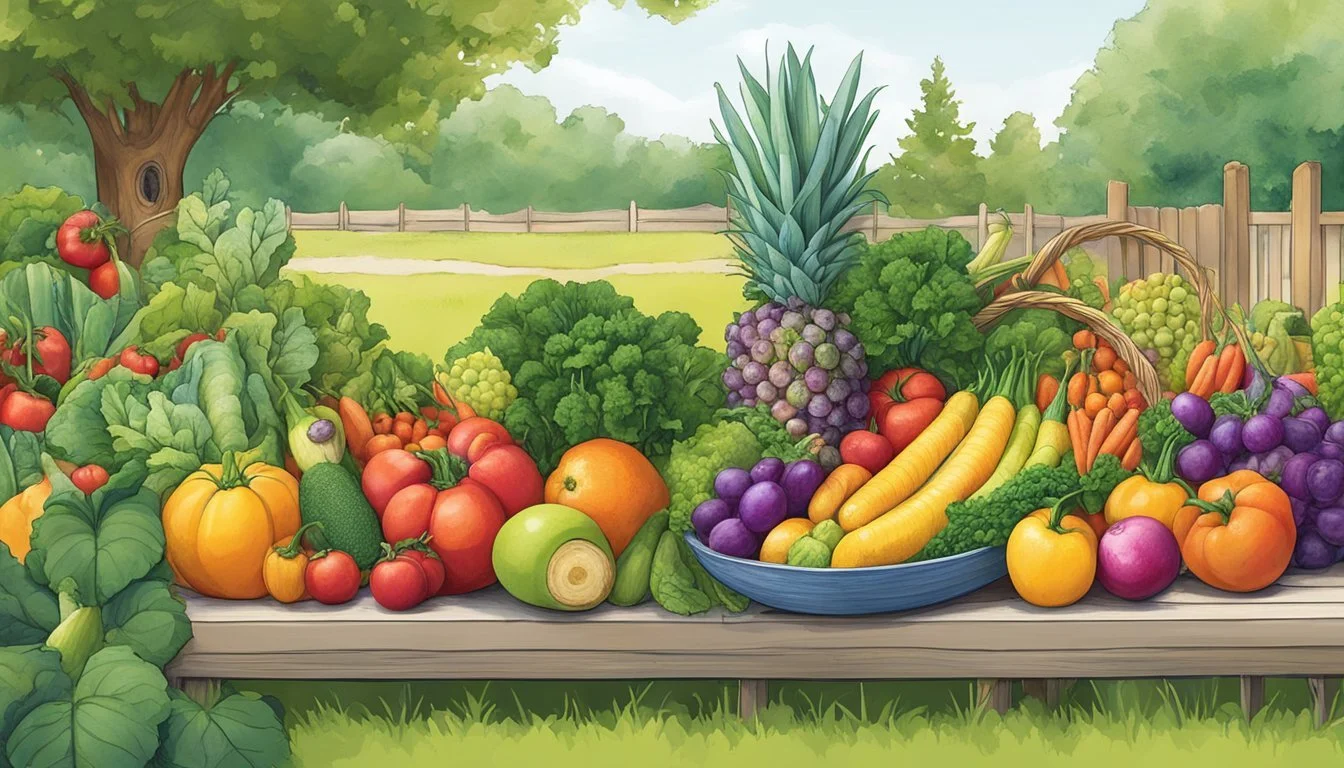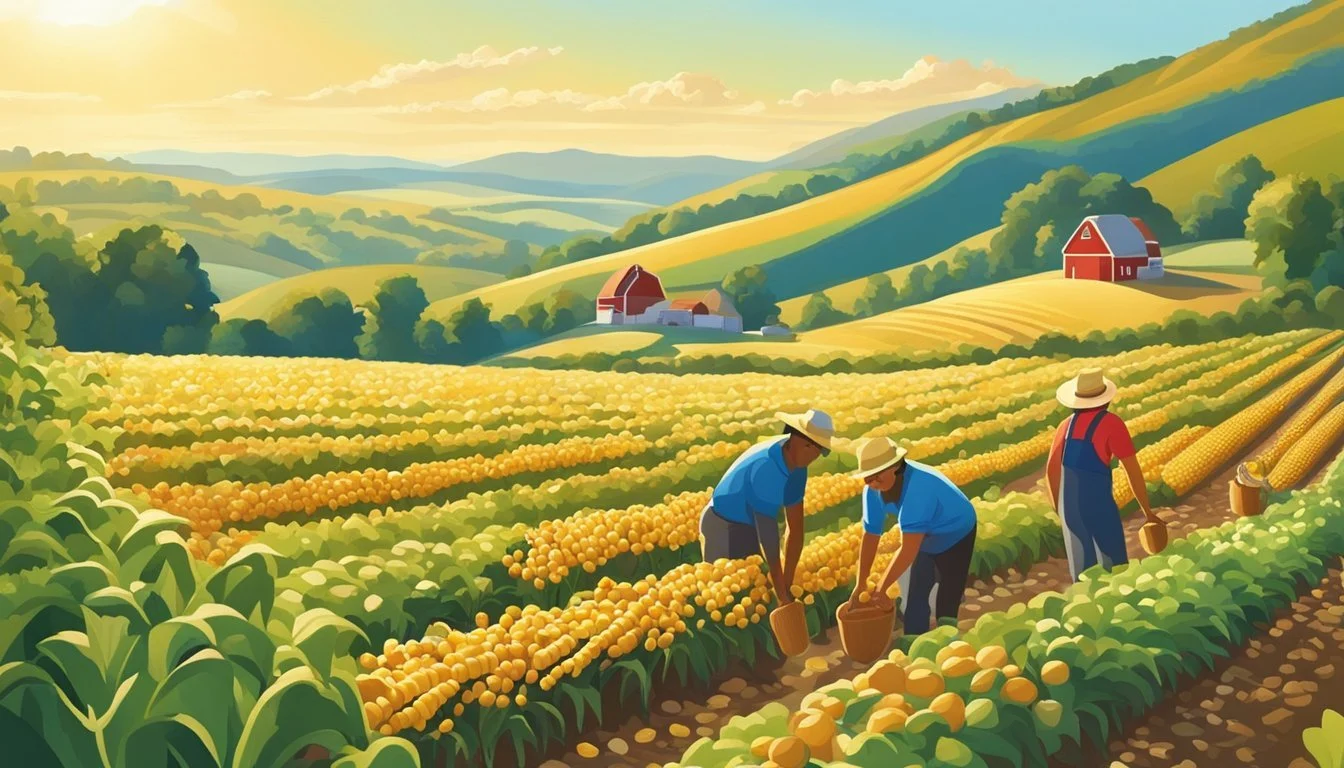North Dakota Seasonal Fruit & Vegetables in July
Your Fresh Picks Guide
This Article is Part of our North Dakota Seasonal Fruit & Veg Calendar
In North Dakota, the height of summer in July brings a bounty of fresh produce to the forefront of the local diet. During this month, farmers' markets and grocery stores are abundant with a variety of fruits and vegetables at their peak freshness and flavor. The fertile plains of the Peace Garden State host a diverse range of crops, taking full advantage of the long, sunlit days.
Seasonal fruits such as blueberries (how long do blueberries last?) are especially popular, offering not only a sweet, flavorful snack but also a boost of antioxidants. These small, vibrant berries are at their best in July and are often associated with classic American desserts like blueberry pie. Alongside them, other seasonal fruits typically include raspberries and strawberries, which add a burst of color and taste to the North Dakota summer.
Vegetables also thrive in the July warmth, with the likes of beets (how long do beets last?), carrots (how long do carrots last?), and cucumbers readily available. Their freshness is unparalleled during this season, making them ideal for a range of dishes from salads to roasted vegetable platters. This availability aligns with a growing consumer interest in farm-to-table eating, supporting local agriculture and providing the freshest options for seasonal cooking.
Overview of North Dakota's Growing Season
North Dakota's growing season is marked by its diverse climate conditions and distinct hardiness zones, which play a crucial role in the variety and timing of crops throughout the state.
Summer Harvest in North Dakota
The summer months in North Dakota bring about the peak of the harvesting season. July, in particular, offers an abundance of fresh produce. The state sees the ripening of various fruits and vegetables during this time. Key crops include:
Fruits: such as strawberries, raspberries, and blueberries
Vegetables: including peas, beans, carrots, and cucumbers
Farmers and gardeners across the state are engaged in picking these crops at their freshest and most flavorful.
Climate and Hardiness Zones
North Dakota's climate is classified as continental, characterized by cold winters and warm summers. The state spans several hardiness zones, mainly ranging from zone 3a to 4b, which indicates the types of plants that can withstand the local winter temperatures. This helps dictate:
The starting time of the growing season
The type of crops that can be successfully cultivated
The length of the harvest period for various produce
The region's climate can pose challenges, but it also provides opportunities for a variety of crops that are well-adapted to the summer season in this part of the state.
Seasonal Vegetables in July
In July, North Dakota's vegetable gardens are thriving with an assortment of fresh produce. Various leafy greens, root vegetables, and nightshade family members arrive at their peak flavor and abundance.
Leafy Greens Availability
During July, leafy greens such as kale and lettuce are readily available in North Dakota. They thrive in the warm, yet not too hot conditions, offering crisp textures and full flavors. Gardens and markets typically boast:
Kale: Both curly and flat varieties
Lettuce: Including romaine, iceberg, and leafy cultivars
Root Vegetables and Bulbs
Root vegetables like carrots and beets are in abundance, their flavors deepened from the summer warmth. These vegetables can be enjoyed both raw and cooked, adding a sweet and earthy dimension to dishes.
Carrots: Ranging from traditional orange to purple, yellow and white varieties
Beets: Known for their rich color and sweet, earthy taste
Nightshade Vegetables in Season
Nightshade vegetables such as tomatoes, peppers, and eggplant (What wine goes well with eggplant?) come into season in July. These are known for their bold flavors and versatility in cooking.
Tomatoes: From cherry to beefsteak, they offer a summer fresh taste.
Peppers: Including bell and spicy varieties, great for adding a kick to meals.
Eggplant: Praised for its meaty texture, it absorbs flavors beautifully in recipes.
Seasonal Fruits in July
July in North Dakota offers a generous harvest of ripe fruits, especially brimming with an assortment of berries and stone fruits. This is the time when fruit lovers can indulge in the freshest and juiciest picks from local farms and markets.
Berries Peak Season
During the month of July, berry production is at its zenith in North Dakota. The most popular picks are:
Strawberries: Often the last of their season in early July.
Blueberries: Bursting with flavor, they are a favorite for their antioxidant properties.
Raspberries: Known for their delicate structure and intense sweetness.
Blackberries: Large and plump, they come into season by late July.
Berries are widely celebrated for their versatility in fresh salads, desserts, and preserves.
Stone Fruits Ripening
Stone fruits reach their peak ripeness in July, offering a tantalizing range of flavors and textures. Consumers should look for:
Nectarines: Smooth-skinned and firmer to the touch when ripe.
Peaches: With a characteristic fuzz on their skin, they soften as they reach peak sweetness.
These fruits can be enjoyed fresh, in baked goods, or canned for year-round consumption. Stone fruits add a succulent burst to any summer dish and are an embodiment of the season's warmth.
Harvesting and Selecting Produce
In North Dakota, July is a time of abundance for gardeners and farmers, and knowing when and how to harvest can profoundly affect both the flavor and longevity of the produce. Proper picking techniques ensure maximum freshness, while understanding ripeness leads to enjoying fruits and vegetables at their flavor peak.
Picking Tips for Maximum Freshness
When harvesting vegetables, one should look for firmness and a vibrant color indicative of peak freshness. For example, beans should snap cleanly, and beets ought to have a smooth outer skin. It's essential to harvest in the morning or evening when the temperatures are cooler to prevent wilting. Leaves should be crisp, and the stem should show no signs of shriveling. When picking fruits such as strawberries or raspberries, they should come off the stem easily if they are ripe. The thumb rule is that if one has to pull hard, the fruit likely needs more time to mature.
Beans: Snap off the plant when firm and before seeds bulge.
Beets: Twist off the greens and look for smooth and unblemished roots.
Understanding Ripeness
Ripeness is not only a matter of color but also feel and, at times, size. A ripe cantaloupe (how long does cantaloupe last?), often found in July in North Dakota, will detach easily from the vine and have a sweet aroma at the stem end. Vegetables like carrots and broccoli are best when their color deepens, but they've not yet become too large and tough. For most vegetables such as tomatoes, squeezing gently should not leave an indentation; if it does, the vegetable could be overripe. Fruits should be firm but yield slightly to pressure; however, texture varies by variety, which is worth considering when assessing ripeness. Eating raw fruits and vegetables can showcase their flavor and freshness, making ripeness crucial for immediate consumption.
Cantaloupe: Sniffs for sweetness at the stem end; a ripe one will have a fragrant smell.
Carrots: Look for vibrant color and medium size for the best flavor and texture.






